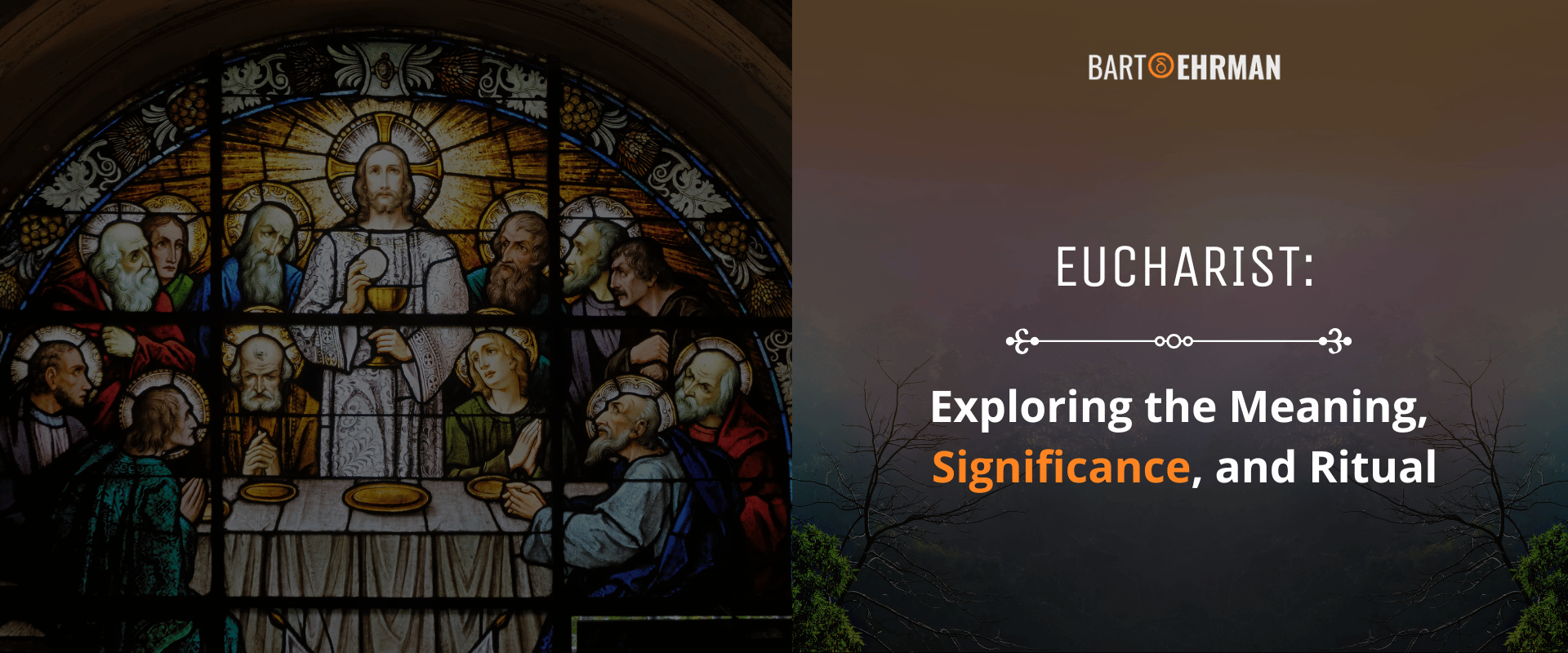Eucharist: Exploring the Meaning, Significance, and Ritual

Written by Joshua Schachterle, Ph.D
Author | Professor | Scholar
Author | Professor | BE Contributor
Verified! See our editorial guidelines
Verified! See our guidelines
Edited by Laura Robinson, Ph.D.
Date written: November 10th, 2024
Disclaimer: The views and opinions expressed in this article belong to the author and do not necessarily match my own. - Dr. Bart D. Ehrman
The term "Eucharist" embodies the profound act of thankfulness that lies at the heart of Christian worship. This sacred meal has shaped the lives of Christians throughout history and continues to resonate in contemporary churches.
In this article, I’ll explore the etymology of the word Eucharist, its biblical occurrences, and its evolution as a central rite within Christianity, uncovering not only its theological implications but also its role as a communal expression of faith in the Christian tradition.

Etymology and Significance
The word Eucharist (pronounced YOO-ka-rist) comes directly from the Greek word eucharistía. The word is made up of two elements: eu means “good or well” while charis means “grace or favor.” Together, they form a word which in Greek means “gratitude or thanksgiving.”
This word can be found in its ordinary connotation as gratitude several times in the New Testament. In Acts 24:2-3, for example, a person accusing Paul of wrongdoing addresses the governor Felix obsequiously, saying
Because of you, most excellent Felix, we have long enjoyed peace, and reforms have been made for this people because of your foresight. In every way and everywhere we welcome this with utmost gratitude (eucharistias).
Paul speaks of giving thanks to God in 2 Corinthians 4:14-15:
… we know that the one who raised Jesus will also raise us with Jesus and will present us with you in his presence. Indeed, everything is for your sake, so that grace, when it has extended to more and more people, may increase thanksgiving (eucharistian), to the glory of God.
Later, the word Eucharist came to signify the Christian rite of the Lord’s Supper or Communion. Although all four Gospels describe Jesus’ initiation of this rite, our oldest description of it and its significance come from Paul in 1 Corinthians 11:23-26, which uses the word in its depiction:
For I received from the Lord what I also handed on to you, that the Lord Jesus on the night when he was betrayed took a loaf of bread, and when he had given thanks (eucharistēsas), he broke it and said, “This is my body that is for you. Do this in remembrance of me.” In the same way he took the cup also, after supper, saying, “This cup is the new covenant in my blood. Do this, as often as you drink it, in remembrance of me.” For as often as you eat this bread and drink the cup, you proclaim the Lord’s death until he comes.
This seems to have been an established ritual even before Paul’s conversion, and so Christians must have instituted it very early. Note also the symbolism in which the broken bread becomes Jesus’ broken body, while the wine in the cup becomes Jesus’ blood. Paul’s description remains a template for the ritual in most churches today.
The significance of the rite appears to be the memorialization of Jesus’ sacrifice: “Do this in remembrance of me.” The depiction of the Eucharist in Luke 22:14-20 uses this phrase as well, although the New Testament does not call the ritual meal the Eucharist.
Nevertheless, it is referred to as the Eucharist in several early Christian writings including the Didache, the letters of Ignatius of Antioch, and Justin Martyr’s First Apology. The likely explanation for the name is that the ritual was a way of remembering, and thus giving thanks for, Jesus’ sacrificial death.
Interestingly, Justin Martyr clearly believed that the bread and wine of the Eucharist were actually Jesus’ body and blood. Here’s what he wrote about it around 150 CE in his First Apology:
Not as common bread and common drink do we receive these; but in like manner as Jesus Christ our Savior, having been made flesh by the Word of God, had both flesh and blood for our salvation, so likewise have we been taught that the food which is blessed by the prayer of His word, and from which our blood and flesh by transmutation are nourished, is the flesh and blood of that Jesus who was made flesh.
Similarly, the 4th- and 5th- century bishop and theologian Augustine of Hippo wrote in a sermon that the bread of the Eucharist actually becomes the body of Christ:
The faithful know what I'm talking about; they know Christ in the breaking of bread. It isn't every loaf of bread, you see, but the one receiving Christ's blessing, that becomes the body of Christ.
The ritual meal is still called the Eucharist by those in the Eastern Orthodox, Oriental Orthodox, Catholic, Anglican, Presbyterian, and Lutheran churches. Most Protestant denominations, however, prefer the terms Communion or Lord’s Supper. While the meaning of the phrase “Lord’s Supper” is self-explanatory, the word “Communion” comes from the Latin communio meaning "fellowship, mutual participation, sharing." This makes sense since the rite is a way of partaking in the grace of Jesus’ sacrifice as well as communing with the other members of the church.
The Eucharist Ritual
Interestingly, one of our earliest records of a community rule for the ritual of the Eucharist has a very different significance from any of the biblical accounts. In the Didache, a late 1st- or early 2nd-century Jewish-Christian document, this ritual meal is almost unrecognizable as the Eucharist written about by Paul and the Gospels.
Before drinking the wine, participants are to pray “We thank you, our Father, for the holy vine of David, your servant, which you have revealed through Jesus, your servant. To you be glory forever.” Then, before eating the bread, they are to pray
We thank you, our Father, for the life and knowledge which you have revealed through Jesus, your servant. To you be glory forever. As this piece of bread was scattered over the hills and then was brought together and made one, so let your Church be brought together from the ends of the earth into your Kingdom. For yours is the glory and the power through Jesus Christ forever.
Notice the total absence of references to Jesus’ death. It would seem, then, that this early Christian community had a very different conception of the Eucharist: it truly was a thanksgiving meal, expressing gratitude to God for food and drink as well as the knowledge brought by Jesus.
While modern denominations differ on how the rite is performed, there are elements common to all. Bread, either leavened or unleavened depending upon the denomination, and wine, or non-alcoholic grape juice in some Protestant traditions, are consecrated ritually on an altar or a communion table and then consumed.
When giving the bread to participants, officiants often say some form of ritual formula, reminding those who partake that it is the body of Christ. Similarly, when giving the wine or juice, the officiant reminds the participant that it is Christ’s blood. Christians generally agree that Christ is present in the ritual, though they differ about exactly how.
Followers of modern denominations have differing views of the Eucharist’s significance. Let’s look at some of these.
FREE COURSE!
WHY I AM NOT A CHRISTIAN
Raw, honest, and enlightening. Bart's story of why he deconverted from the Christian faith.
Over 6,000 enrolled!
Significance of the Eucharist in Various Denominations
For Catholics and Orthodox Christians, the Eucharist is one of the sacraments. This word is derived from the Latin word sacramentum meaning “something holy.” A sacrament is a ritual which imparts divine grace to those participating.
In Changing Churches: An Orthodox, Catholic, and Lutheran Theological Conversation, Mickey Mattox and A.G. Roeber write about some of the differences in the theology of the Eucharist for Catholics, Orthodox, and Lutheran Christians. The Catholic Church, for instance, asserts that when the priest consecrates the elements of the Eucharist, the bread and wine actually become the body and blood of Jesus Christ, a process known as transubstantiation. Therefore, when a participant ingests the consecrated bread and wine, they are literally taking the body and blood of Jesus into their own bodies. Eastern and Oriental Orthodox denominations agree with this doctrine, although they do not use the word transubstantiation.
(Affiliate Disclaimer: We may earn commissions on products you purchase through this page at no additional cost to you. Thank you for supporting our site!)
Lutherans also believe the body and blood of Christ are really present "in, with, and under" the bread and wine. They call this doctrine the sacramental union. Reformed or Calvinist Christians, on the other hand, believe that the spiritual presence of Christ is in the performance of the ritual of Communion, according to Donald McKim in Major Themes in the Reformed Tradition. However, they do not believe it is physically present in the bread and wine as Catholic, Orthodox, or Lutheran Christians do.
In Christian Confessions: A Historical Introduction, Ted A. Campbell writes that all forms of the Anglican or Episcopal church believe that Christ is actually present in the Eucharist. However, Evangelical Anglicans believe that this is a spiritual presence, not unlike modern Calvinists, while Anglo-Catholics believe in a corporeal presence in the bread and wine.
Most other Protestants, including Evangelicals, believe that the bread and wine are merely symbols of Christ’s body and blood. They, indeed, perform the ritual as a memorialization of Jesus’ death, but do not believe in the real presence of Christ in the bread or the wine.
How often should Christians partake of the Eucharist? According to Canon Law #920 of the Catholic Church, after receiving their first communion, Catholics should take it at least once a year. Orthodox Christians agree with this, although according to the Orthodox Church in America, “Provided that an Orthodox Christian has properly prepared himself or herself through prayer, fasting, repentance, and reflection on his or her life, he or she can receive Holy Communion whenever a Divine Liturgy is celebrated.”
Lutherans generally offer the Eucharist every week and ask church members to take it also during festivals such as Easter and Christmas. In Reformed Churches, “The Lord's Supper, or communion, is celebrated infrequently—perhaps four to six times a year—and is viewed by the congregation as something of a special occasion.”
Anglican or Episcopal churches generally offer the Eucharist at every weekly service, although it may be provided more frequently when there are special church holidays. Most other Protestant denominations, such as Baptists and Evangelicals, generally take communion once a month, according to the National Association of Evangelicals.

Conclusion
Whether it’s called the Eucharist, Holy Communion, the Lord’s Supper, or the Blessed Sacrament, the ritual meal celebrating Jesus’ sacrifice on the cross is celebrated regularly by most Christian denominations.
The word Eucharist comes from the Greek word for thanksgiving or gratitude. It denotes the ritual meal referred to in the letters of Paul and the Gospels, in which Jesus offered bread and wine to his disciples as his body and blood, instituting a church practice of remembering Jesus’ sacrifice.
While the Didache seemed to see the significance of this ritual meal as giving thanks for food and drink, most churches see the meal as the memorialization of Jesus’ sacrifice on the cross. The differences come in each denomination’s interpretation of the meal.
For Catholics, Orthodox Christians, and some others, the bread and wine actually become Jesus’ body and blood through a mystical transformation, meaning that those who partake are uniting in some way with Christ.
For most Protestant and Evangelical Churches however, the ritual meal is merely symbolic, a way to commemorate and celebrate Jesus’ sacrifice on the cross.
FREE COURSE!
WHY I AM NOT A CHRISTIAN
Raw, honest, and enlightening. Bart's story of why he deconverted from the Christian faith.
Over 6,000 enrolled!
